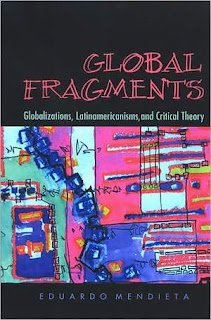Laikwan Pang: The Distorting Mirror: Visual Modernity in China (2007)
Filed under book | Tags: · advertising, china, cinema, film, modernity, photography, theatre, visual culture

“The Distorting Mirror analyzes the multiple and complex ways in which urban Chinese subjects saw themselves interacting with the new visual culture that emerged during the turbulent period between the 1880s and the 1930s. The media and visual forms examined include lithography, photography, advertising, film, and theatrical performances. Urbanites actively engaged with and enjoyed this visual culture, which was largely driven by the subjective desire for the empty promises of modernity—promises comprised of such abstract and fleeting concepts as new, exciting, and fashionable.
Detailing and analyzing the trajectories of development of various visual representations, Laikwan Pang emphasizes their interactions. In doing so, she demonstrates that visual modernity was not only a combination of independent cultural phenomena, but also a partially coherent sociocultural discourse whose influences were seen in different and collective parts of the culture. The work begins with an overall historical account and theorization of a new lithographic pictorial culture developing at the end of the nineteenth century and an examination of modernity’s obsession with the investigation of the real. Subsequent chapters treat the fascination with the image of the female body in the new visual culture; entertainment venues in which this culture unfolded and was performed; how urbanites came to terms with and interacted with the new reality; and the production and reception of images, the dynamics between these two being a theme explored throughout the book.
Modernity, as the author shows, can be seen as spectacle. At the same time, she demonstrates that, although the excessiveness of this spectacle captivated the modern subject, it did not completely overwhelm or immobilize those who engaged with it. After all, she argues, they participated in and performed with this ephemeral visual culture in an attempt to come to terms with their own new, modern self.”
Publisher University of Hawaii Press, 2007
ISBN 0824830938, 9780824830939
280 pages
PDF (updated on 2013-8-26)
Comments (2)Andrew Benjamin, Charles Rice (eds.): Walter Benjamin and the Architecture of Modernity (2009)
Filed under book | Tags: · architecture, city, modernity, urbanism

Walter Benjamin is universally recognized as one of the key thinkers of modernity: his writings on politics, language, literature, media, theology and law have had an incalculable influence on contemporary thought. Yet the problem of architecture in and for Benjamin’s work remains relatively underexamined. Does Benjamin’s project have an architecture and, if so, how does this architecture affect the explicit propositions that he offers us? In what ways are Benjamin’s writings centrally caught up with architectural concerns, from the redevelopment of major urban centres to the movements that individuals can make within the new spaces of modern cities? How can Benjamin’s theses help us to understand the secret architectures of the present? This volume takes up the architectural challenge in a number of innovative ways, collecting essays by both well-known and emerging scholars on time in cinema, the problem of kitsch, the design of graves and tombs, the orders of road-signs, childhood experience in modern cities, and much more. Engaged, interdisciplinary, bristling with insights, the essays in this collection will constitute an indispensable supplement to the work of Walter Benjamin, as well as providing a guide to some of the obscurities of our own present.
Publisher re.press, Melbourne, July 2009
Anamnesis series
Creative Commons BY-NC-ND 2.5 license
ISBN 9780980544022
224 pages
Eduardo Mendieta: Global Fragments: Globalizations, Latinamericanisms, and Critical Theory (2007)
Filed under book | Tags: · critical theory, critique, ethics, globalisation, latin america, modernity, philosophy, postmodern, religion

Global Fragments offers an innovative analysis of globalization that aims to circumvent the sterile dichotomies that either praise or demonize globalization. Eduardo Mendieta applies an interdisciplinary approach to one of the most fundamental experiences of globalization: the mega-urbanization of humanity. The claim that globalization unsettles our epistemic maps of the world is tested against a study of Latin America. Mendieta also recontextualizes the work of three major theorists of globalization—Enrique Dussel, Cornel West, and Jürgen Habermas—to show how their thinking reflects engagement with central problems of globalization and, conversely, how globalization itself is exemplified through the reception of their work. Beyond the epistemic hubris of social theories that seek to accept or reject a globalized world, Mendieta calls for a dialogic cosmopolitanism that departs from the mutuality of teaching and learning in a world that is global but not totalized.
Publisher SUNY Press, 2007
ISBN 0791472574, 9780791472576
Length 226 pages
More info (publisher)
More info (google books)

